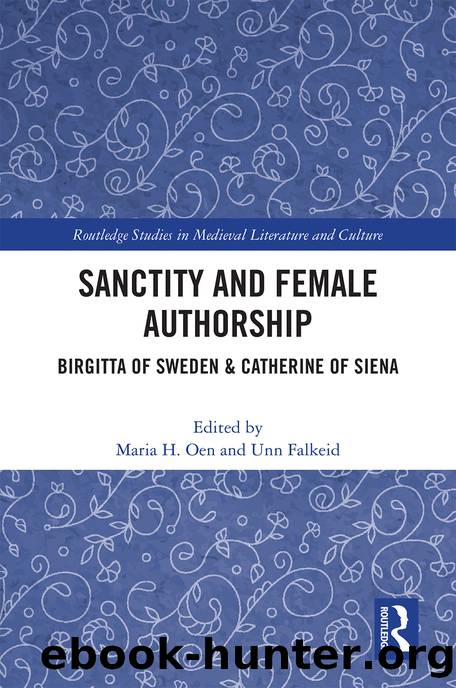Sanctity and Female Authorship by Oen Maria H.; Falkeid Unn;

Author:Oen, Maria H.; Falkeid, Unn;
Language: eng
Format: epub
Publisher: Taylor & Francis Group
Published: 2020-02-15T00:00:00+00:00
Figure 6.1 Author portrait of Birgitta of Sweden writing down her revelations. Siena, Biblioteca comunale degli Intronati, I.V.25, fol. 11v. Date: 1399. Photo: Biblioteca comunale degli Intronati.
Conspicuous in this transformed version of the author-cum-scribe portrait compared with the original in the Neapolitan codex is the removal of all witnesses, combined with the evident focus on the prominent figure of the author, whose importance in the image is increased at the expense of the divine source of inspiration, here reduced considerably in size. In the New York frontispiece, although the perspective is from Birgittaâs angle, the celestial sphere takes up the bulk of the folio. Here, the scribe at work is manifestly the principal motif. The display of the pen and knife in Birgittaâs hands, together with ink spilled over the desk, further emphasizes human labor and the practical conditions related to the production of the physical text. In other words, although clearly based on the Neapolitan model, the Sienese author portrait seems to attribute even more value to the saintâs active involvement in the production of the work. As such, the Sienese Birgitta calls to mind the contemporary evangelist portraits that Laura Kendrick has identified as visual expressions of what was a new approach in scholastic exegesis regarding the role of the human authors of Scripture.40 As argued famously by Alastair Minnis, in university circles in the thirteenth and fourteenth centuries, there was a great interest in the individual intentions of the human writers of the scriptural texts, believed to be expressed in the literal sense (sensus literalis) of the Bible.41 This perspective on the function of Godâs âhuman pensâ offered a solution to the problem of concordance between the various biblical books, notably the Gospels, and implied an acknowledgment of the cooperation between the individual writer and divine will. Kendrick has drawn a connection between what she perceives to be not only a renewed interest in the evangelist author portrait in this very period but also the particular emphasis on the manual labor in these illuminations and the contemporary scholastic approach to the intentions of the human authors of the Bible.42 It is tempting to see the similar highlighting of Birgittaâs labors as a scribe in the Siena codex as another example of this particular attitude to the biblical auctores. Indeed, the very concept of Birgitta, a contemporary woman, writing Scripture bears testimony to this transformed understanding of the associations between divine and human authorship and thus also of literary auctoritas.43
As noted above, the Sienese Birgitta manuscript plays an important role in the context of this study as it manifests knowledge among the followers of Catherine of the specific visual and textual strategies used to legitimize the public voice of the Swedish saint. Moreover, the author portrait in Cristoforoâs codex has been attributed to various artists who were crucial in the promotion of the cult of Catherine.44 Neverthelessâand despite the proclamation of Birgittaâs sanctity a few years before, which suggests that she could make an excellent model for Catherineâs
Download
This site does not store any files on its server. We only index and link to content provided by other sites. Please contact the content providers to delete copyright contents if any and email us, we'll remove relevant links or contents immediately.
Stepbrother Stories 2 - 21 Taboo Story Collection (Brother Sister Stepbrother Stepsister Taboo Pseudo Incest Family Virgin Creampie Pregnant Forced Pregnancy Breeding) by Roxi Harding(11019)
Kathy Andrews Collection by Kathy Andrews(10510)
Tell Tale: Stories by Jeffrey Archer(8244)
The Mistress Wife by Lynne Graham(5853)
This Is How You Lose Her by Junot Diaz(5755)
Dancing After Hours by Andre Dubus(4826)
The Last Wish (The Witcher Book 1) by Andrzej Sapkowski(4649)
The Sympathizer by Viet Thanh Nguyen(3468)
Maps In A Mirror by Orson Scott Card(3407)
The Secret Wife by Lynne Graham(3339)
Be in a Treehouse by Pete Nelson(3207)
Tangled by Emma Chase(3183)
Ficciones by Jorge Luis Borges(2854)
The House on Mango Street by Sandra Cisneros(2774)
Girls Who Bite by Delilah Devlin(2701)
A Knight of the Seven Kingdoms by George R R Martin(2620)
You Lost Him at Hello by Jess McCann(2456)
MatchUp by Lee Child(2361)
Once Upon a Wedding by Kait Nolan(2339)
